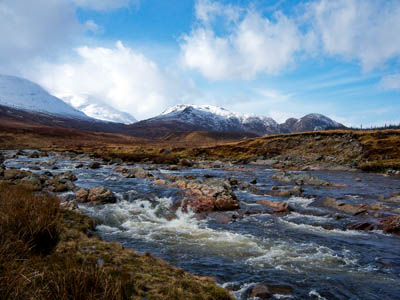
The River Spey, with its origins high in the Monadh Liath mountains, will be the first water core path. Photo: Graham Lewis ![[CC-2.0]](/lib/img/layout/cc-attr.gif)
Walkers planning to follow one of Scotland’s newest paths will end up with wet feet.
Uniquely, the Cairngorms National Park Authority has included the surface of the River Spey in its lists of core paths – set up under the country’s right-to-roam law, encouraging canoeists, kayakers and other paddlesport fans to use the length of Scotland’s second longest river.
The authority will now adopt the core-path plan after approval from the Scottish Government. The inclusion of the river is the first such instance in Scotland. The authority said: “This is likely to result in a better managed river catering more effectively for the needs of the diverse range of users who enjoy it.”
It may seem odd to designate a stretch of river as a path, but the Land Reform (Scotland) Act, unlike access legislation in England and Wales, gives the right of access to water as well as land, for recreational use.
The Cairngorms Campaign, a charitable pressure group formed to resist damaging development in the national park, said: “We welcome and support this bold move to designate the River Spey as a water-based core path. This move recognises the national importance of the Spey for canoeing and kayaking, especially given the potential for multi-day voyages.
“This is exactly the benefits we expect from a national park, and would like to see contiguous sections of the Dee similarly designated in the next version of the plan.”
Some fishing and angling organisations resisted the proposal to make the Spey a core path, saying increased use of the river by paddlesport enthusiasts would damage and deter their activities, but the Scottish Canoe Association countered: “Having been used as a natural waterway by the logging companies in previous centuries and its legal navigable rights confirmed in modern times by the House of Lords ruling in the Wills v Freshwater case in the early 1970s, the river can be negotiated by small boat, canoe or kayak with relative ease and immense pleasure for over 70 miles [113km] of its total length.
“Thus, it is a path in the true sense of the word: ‘a course, route, line along which anything moves’.”
A total of 1,197 people were involved in three consultative phases of the core-path plan, producing a blueprint to encourage more people into the outdoors and help land managers to manage access across land and water.
The Cairngorms authority has designated 932km (579 miles) of core paths in its area.
David Green, convener of the Cairngorms National Park Authority said: “Now that the core-paths plan has been approved, the development of a more integrated network of paths for a wider range of people and abilities to enjoy the special qualities of the Cairngorms national park can be taken forward.
“Once completed the work will allow users to move around and enjoy the park more easily while minimising conflict with farmers, foresters and estates who manage the land.
“The park authority already supports the work of the Cairngorms Outdoor Access Trust and I look forward to more projects coming forward like the new school path in Strathdon and the new bridge over the River Gynack in Kingussie.
“I would also like to thank members of the Cairngorms Local Outdoor Access Forum who advised on the consultation process over a sustained period. With their input, the park authority went about developing the Cairngorms core paths plan in a very thorough, transparent and consultative way, resulting in just one alteration being directed by the minister following extensive consultations and a public inquiry.”
The idea of introducing to Scotland a system of core paths has its sceptics among the outdoor community. As grough contributor Dave Hewitt points out while writing on the recent Balmoral paths brouhaha on the Caledonian Mercury website: “Ironically, there is walking-community distrust of the whole core-path concept, with many seeing it as undermining and ‘corridorising’ broader access rights.
“Core paths, so the argument goes, risk moving Scotland closer to the more restrictive English rights-of-way situation.”
Bob White
31 January 2010The Land Reform Bill grants access to rivers but it is with responsibility which a lot of the access takers do not understand.
On any salmon river anglers and paddlers can not get on in low water levels as the disturbance paddlers cause ruins the fishing.
24/7/365 does not work. There has to be more guidelines.
At the moment the access takers ie paddlers think they have a right to be there no matter the conditions but unfortunately that does not work and fishermen that put a lot into local communities in the way of revenue suffer and eventully will not come back.
Bob White, Ghillie on the river Tay
Matt T
01 February 2010Short sighted Bob.
Rivers like the Spey and Tay are not enjoyable by paddlers in low water as you'd end up walking most of the route.
As with the Tyne Catchment in England it has been shown that paddling and fishing can coexist.
Do not put at a detriment the balanced view of most Scots as opposed to the bias of the english.
Paddlers, Fishermen and Outdoor enthusiasts ALL put a lot of revenue into local communities.